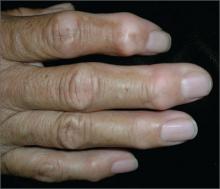The FP diagnosed osteoarthritis (OA) after noting Heberden’s nodes and Bouchard’s nodes at the distal and proximal interphalangeal joints, respectively.
Arthritis is the most common cause of disability in the United States. Twenty-one million adults have functional limitations because of arthritis. Fifty percent of adults ages 65 years or older have been given an arthritis diagnosis. The most commonly affected joints are the knees, hips, hands (distal and proximal interphalangeal joints), and spine. If the diagnosis is uncertain, plain x-rays can often differentiate between OA and other forms of arthritis.
Treatment for OA centers around pain relief and includes acetaminophen and nonsteroidal anti-inflammatory drugs (NSAIDs). Since there is no real inflammation, anti-inflammatory medications have no proven advantage over analgesics such as acetaminophen. The FP suggested acetaminophen at a dose not to exceed 4 g/d. The FP also suggested that the patient exercise, as well as use over-the-counter NSAIDs in addition to acetaminophen intermittently if the acetaminophen failed to provide sufficient pain relief.
Photo and text for Photo Rounds Friday courtesy of Richard P. Usatine, MD. This case was adapted from: Chumley H, Usatine R. Arthritis overview. In: Usatine R, Smith M, Mayeaux EJ, et al, eds. Color Atlas of Family Medicine. 2nd ed. New York, NY: McGraw-Hill; 2013:562-568.
To learn more about the Color Atlas of Family Medicine, see: www.amazon.com/Color-Family-Medicine-Richard-Usatine/dp/0071769641/
You can now get the second edition of the Color Atlas of Family Medicine as an app by clicking on this link: usatinemedia.com


